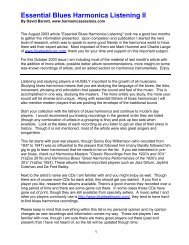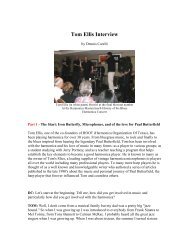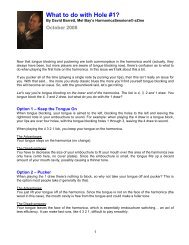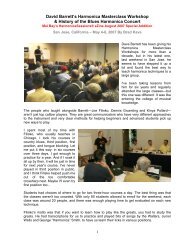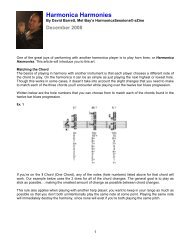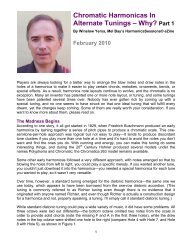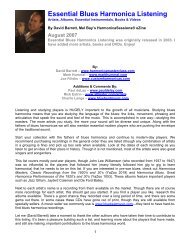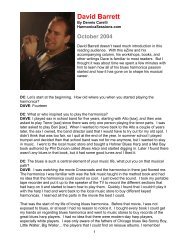Print this Article - Mel Bay's Harmonica Sessions
Print this Article - Mel Bay's Harmonica Sessions
Print this Article - Mel Bay's Harmonica Sessions
You also want an ePaper? Increase the reach of your titles
YUMPU automatically turns print PDFs into web optimized ePapers that Google loves.
Chromatic for Diatonic Players<br />
Blues Chromatic, Part 6.2: Blues in D with the<br />
Big Chord Approach<br />
By Winslow Yerxa, <strong>Mel</strong> Bay’s <strong>Harmonica</strong><strong>Sessions</strong>® eZine<br />
June 2009<br />
Harmonies and Octaves with Split Intervals<br />
Part of the characteristic sound of blues chromatic is the sound of two-note harmony created by<br />
note several holes apart. You create these harmonies by blocking out the intervening holes with<br />
your tongue and sounding the notes in the right and left corners of your mouth, as shown in<br />
Figure D:<br />
Click here (visit www.<strong>Harmonica</strong><strong>Sessions</strong>.com for these media files) to listen to some lines that<br />
show off the characteristic sounds of these splits: 22-0D.mp3<br />
Split intervals deserve a full-length article, which is why I wrote one back in the April 2006 issue<br />
of <strong>Harmonica</strong><strong>Sessions</strong>.com. You can read it here:<br />
http://www.harmonicasessions.com/apr06/Chromatic.html<br />
1
In that article, I explain how to get comfortable with splits where your mouth covers three, four,<br />
and even five holes. I recommend that your work out with that article to develop basic fluency<br />
with splits.<br />
When you play an entire line with a one-hole, two-hole, or three-hole split, you play with a locked<br />
split. A two-hole split gives the riches sounding harmony, but one of the combinations sounds<br />
discordant. When you have the note A on the right side of the split and B on the left side.<br />
You can often harmonize a whole line in a locked split – where you choose a one-hole, two-hole,<br />
or three-hole split, lock it in place, and then use that split to harmonize the whole line. This works<br />
fine for all notes in one-hole splits and three-hole splits.<br />
Two-hole splits produce the richest sounding harmonies, but there’s a potential problem. One of<br />
the two-hole splits gives you a very discordant combination, with A on the right side and B on the<br />
left. If you’re moving quickly <strong>this</strong> may not matter. But sometimes it really sounds bad.<br />
So how do you deal with the one bad-sounding two-hole split? You could play a slap or a plain<br />
single note instead, but <strong>this</strong> breaks up the consistent harmony. To keep a consistent two-note<br />
harmony, you can just use a one-hole split whenever you play an A in the melody. To do <strong>this</strong>,<br />
you have to learn to adjust the size of your embouchure while playing.<br />
The licks in Example 22-3 give you lines that can be played with a two-hole split without any<br />
discord. Click here to listen: 22-03a.mp3<br />
You can also try Example 22 with a one-hole split. Click here to listen: 22-03b.mp3<br />
The licks in Example 22-4 include the note A; you can play them with a locked one-hole split.<br />
Click here to listen: 22-04.mp3<br />
The licks in Example 22-05 use mostly two-hole splits. However, when A is the top note, I switch<br />
to a one-hole split. The tab shows the blocked holes and the left-side holes to better illustrate<br />
where the shifts occur. If you want to gain fluency in playing split harmony lines, practice these<br />
licks. Click here to listen: 22-05.mp3<br />
2
Octaves<br />
A three-hole split will give you an octave. When you play octaves, you play two of the same note<br />
in different ranges. The sound is both powerful and clean, with a bit of sizzle brought by the<br />
reinforcement one note brings to the other. Unlike the diatonic, the chromatic offers all notes as<br />
true octaves.<br />
However, octaves on the chromatic require a wide mouth opening – you need to have five holes<br />
in your mouth, and block out three with your tongue. You may not develop the ability to play<br />
clean octaves overnight, but it’s worth working on. Again, I cover the technique for playing<br />
octaves along with other split intervals in the April 2006 issue.<br />
Click here to hear Example 22-3 played with a three-hole split: 22-03d.mp3<br />
Once you develop confidence with the octave embouchure, you can play nearly any line in<br />
octaves.<br />
Shimmering a Note<br />
A shimmer is a subtle effect that lets you quickly alternate two single notes that are several holes<br />
apart. You block all but the hole to the right, and then shift your tongue to the left so that you’re<br />
blocking all but the hole to the left, as shown in Figure E.<br />
You just wiggle back and forth to rapidly alternate the notes. You may move the tip of your<br />
tongue across the mouthpiece like you do with a rake, or you may leave the tip of your tongue<br />
planted in place and use a subtle jaw flick to influence it to one side or the other.<br />
Click here to hear shimmers, first with the action slowed down, then at normal speed: 22-0E.mp3<br />
Shimmers, like hammers and rakes, are most effective on long notes. Try using shimmers on<br />
some of the long notes in the previous examples.<br />
Using the Big Chord over a One-chord Groove<br />
Click here for a backing track that stays on a D chord. You can practice licks,<br />
lines, and tonguing techniques without worrying about chord changes or a tune form. When<br />
you’re ready, you can move on to playing over chord changes.<br />
Using the Big Chord in 12-bar Blues<br />
The big D minor 6 draw chord is just one chord, and the blues has three chords. How do you use<br />
the big-chord approach to play 12-bar blues?<br />
4
Once again, the harmonica proves itself mysteriously well adapted to playing blues in an intuitive<br />
way. All you need to do is use the draw chord to cover two of the three chords, and the blow<br />
chord for the remaining chord – you don’t even have to use the slide. How easy is that!<br />
In the key of D, the three main chords are D (the I chord), G (the IV chord), and A (the V chord).<br />
The draw chord works over the D and G chords, while the blow chord works over the A chord.<br />
Example 22-6 shows the chord progression for a simple 12-bar blues in D. Each diagonal slash<br />
represents one beat. You can see where to focus mostly on the draw chord, and where to focus<br />
on the blow chord. Click here to listen: 22-06.mp3<br />
The D minor draw chord works over the I chord (D7). (Actually, it clashes slightly, but in a good<br />
way – a bluesy way.) But one cool thing about the big D minor 6 chord is that it also functions as<br />
a G7 chord. D7 is the I chord and G7 is the IV chord, and either way <strong>this</strong> chord sounds bluesy,<br />
so right there you’ve got two of the three main chords covered.<br />
So what about the V chord, A7? Well, the blow chord, even though it’s a C chord, functions like<br />
an A7 chord. Compare the notes:<br />
A7: A C# E G<br />
C: - C E G<br />
The two chords have E and G in common. The C note in the C chord may seem like a clash with<br />
the C# in the A7 chord, but C functions as a blue note in <strong>this</strong> context – again, the note layout of<br />
the chromatic has a bluesy sound built right in. Essentially you can get through the A7 chord by<br />
giving more time to the blow notes – along with all the slaps, pull-offs, hammers, rakes, split<br />
intervals, and shimmers.<br />
5
Lines that work over the I and IV chords<br />
The I chord (D7) and the IV chord (G7) occur during the first 8 bars of a 12-bar blues, as shown<br />
in Example 22-7.<br />
Try some of the licks in the article and find ways to place them over <strong>this</strong> section of the tune.<br />
While the draw chord works well, find ways to emphasize the note G (Blow 3, Blow 7, and Blow<br />
11) during the G chord.<br />
Click here to play along with a backing track that repeats the first 8 measures of a 12-bar blues<br />
22-07.mp3.<br />
Lines that work over the V chord<br />
Example 22-8 shows a simple form of the chord progression during the last 4 bars of a 12-bar<br />
blues, including the V chord (A7), together with the IV chord (G7) and the I chord (D7). Click<br />
here to listen or to play along <br />
Example 22-9 shows typical lines that emphasize the blow notes during the A chord in the third<br />
part of the 12-bar progression. I have not written in the split intervals or tonguing effects. If you<br />
internalize the previous exercises by listening and playing, you’ll be develop the ability to pick<br />
them out when you hear them.<br />
Note: 22-9a and 22-9b start before the V chord begins. A short sequence of notes that leads into<br />
a section of music is called a pick-up. Click here to listen to the licks: 22-09.mp3<br />
6
Try adapting licks from elsewhere in the article, and change the rhythms (or add notes) to<br />
emphasize the blow notes.<br />
Next Time<br />
Using the chromatic slide with the big chord<br />
Recommended Book – Basic Blues Chromatic<br />
http://harmonicamasterclass.com/bc.htm<br />
Notation Key<br />
Please visit http://www.harmonicasessions.com/feb05/ChromaticTab.pdf for a notation key.<br />
7



